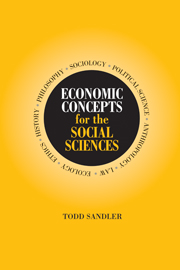Book contents
- Frontmatter
- Contents
- Table and Figures
- Preface
- 1 Economics without Apology
- 2 Back to the Future: Political Economy
- 3 In Another's Shoes: Games, Strategies, and Economics
- 4 It Takes Two or More: Public Economics and Collective Action
- 5 Government for the Politician? Public and Social Choice
- 6 Institutions Matter: The New Institutional Economics
- 7 Knowledge Is Power: Asymmetric Information
- 8 Everything Ties Together: General Equilibrium
- 9 Laboratory Economics: Of Rats and Men
- 10 Before Yesterday and Beyond Tomorrow: Intergenerational Economics
- 11 Fish, Space, and Spaceship Earth: Bioeconomics and Interdisciplinary Economics
- 12 Crystal Ball Economics: Rational Expectations
- 13 How Do We Get There from Here? Transition Economies and Policy Reforms
- 14 Economic Growth: Endogeneity, Institutions, and Other Concepts
- 15 Economic Visions of Future Horizons
- References
- Author Index
- Subject Index
11 - Fish, Space, and Spaceship Earth: Bioeconomics and Interdisciplinary Economics
Published online by Cambridge University Press: 14 May 2010
- Frontmatter
- Contents
- Table and Figures
- Preface
- 1 Economics without Apology
- 2 Back to the Future: Political Economy
- 3 In Another's Shoes: Games, Strategies, and Economics
- 4 It Takes Two or More: Public Economics and Collective Action
- 5 Government for the Politician? Public and Social Choice
- 6 Institutions Matter: The New Institutional Economics
- 7 Knowledge Is Power: Asymmetric Information
- 8 Everything Ties Together: General Equilibrium
- 9 Laboratory Economics: Of Rats and Men
- 10 Before Yesterday and Beyond Tomorrow: Intergenerational Economics
- 11 Fish, Space, and Spaceship Earth: Bioeconomics and Interdisciplinary Economics
- 12 Crystal Ball Economics: Rational Expectations
- 13 How Do We Get There from Here? Transition Economies and Policy Reforms
- 14 Economic Growth: Endogeneity, Institutions, and Other Concepts
- 15 Economic Visions of Future Horizons
- References
- Author Index
- Subject Index
Summary
Adam Smith taught us that the division of labor could keep down costs and promote economic efficiency. Thus, one set of workers cuts the wires for the pins, another straightens them, and still another attaches the heads. The ability to exploit gains from this division of labor is limited by the extent of the market; the larger the market, the greater the division of labor. Academia is also characterized by a division of labor where scholars are separated into disciplines; those disciplines are further subdivided into fields and even subfields. This division has both advantages and disadvantages in the pursuit of knowledge. Specialization has allowed scholars to become experts within a narrow range of topics, which in turn has promoted the rapid acquisition of knowledge. In the process, fields and subfields have created their own jargon, terminology, notation, and methods that present an entry barrier to others. Many problems involve relationships derived from multiple disciplines and cannot truly be understood with the tools of a single discipline. For such problems, an interdisciplinary approach is required.
In the study of a renewable resource such as a fishery, economic decisions and forces impinge on both the fishing industry and the biological relationships that influence the supply of fish. Biological forces also constrain economic decisions regarding harvesting the fish in both the short run and the long run. Bioeconomics investigates the interrelationship between an economic and a biological system, so that equilibria and adjustments to disequilibria account for the influences of both systems.
- Type
- Chapter
- Information
- Economic Concepts for the Social Sciences , pp. 185 - 202Publisher: Cambridge University PressPrint publication year: 2001



